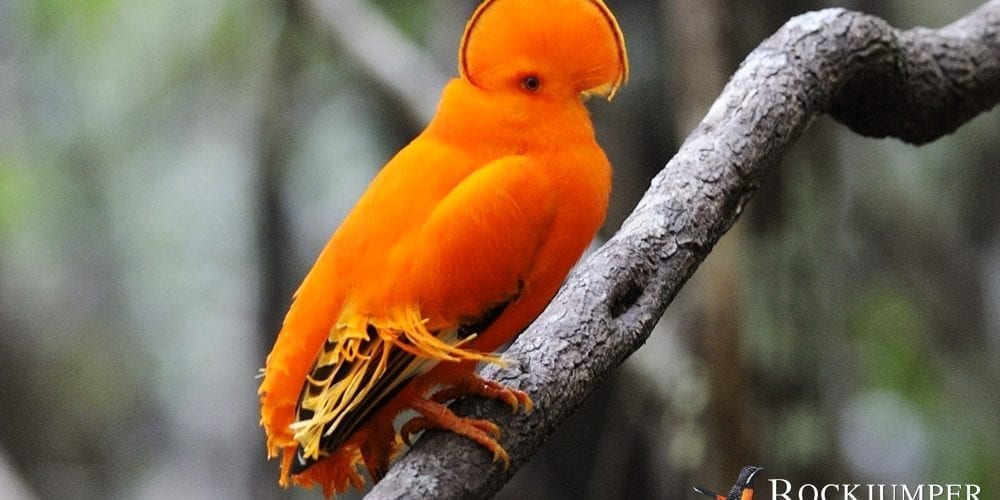
The sea of green beneath us is sparsely dotted with flecks of yellow, orange, and the occasional pink. Meandering dark rivers weave their way in intricate shapes for unknown distances, flowing from the Andes into, eventually, the Amazon. We fly low. We fly slow. We are travelling in a truly historic vessel: the venerable DC 3, known as the “workhorse” of numerous wars around the world. It was the first mass-produced civil/commercial aircraft to popularise commuter air travel. Pilots around the globe have been heard to say, “The only replacement for a DC 3, is another DC 3.” For us, it was a replacement for our flight to Mitu, Colombia, aboard a much more common mode of air travel with the only company in Colombia known to fly a commercial jet to our destination. This company turned out to live up to its reputation as being completely unreliable, despite paid-in-full reservations. The DC 3 we were flying in, and the charter company that removed cargo from its innards to install extra seats for us, proved to be much more reliable, as their respective reputations seem to attest. As we flew a mere 600 metres above the Amazonian wilderness stretching out, languishing in the heat of one of the most powerful dry seasons on record, we were all feeling very grateful.
So began the journey. In a quest, of sorts, that we had devised, slowly, over the years prior to 2013. Colombia was blossoming. I had had the privilege of getting to travel to most, though not nearly all, of the rare corners of this natural wonderland in search of most (again not all) of the prized bird and mammal species that the world-at-large was just beginning to recognise could be found within the political boundaries of this previously taboo country. Until a decade ago, only very few people even considered travelling to Colombia, numbering only slightly more than people who could point it out on the globe without squinting. After some two dozen visits, I had acquiesced to my boss’s request to formulate an itinerary that could feasibly net more than 1,000 species of birds in less than a month, thinking that, by now, I ought to know how to pull this feat off or I never would.
That’s the backstory of how the nine of us found ourselves aboard a DC 3, en route from Villavicencio to the nearly entirely uncatalogued backcountry of the Colombian Amazon, at Mitu. The more contemporary backstory to our circumstance would be that Airline X (not to be named out of respect for recent improvements in the airline….and possible claims of libel) botched our reservations, yet managed to charge us fully, for their twice-a-week air service which precipitated the relatively last-minute (three days prior) decision to charter seats on a cargo plane bound from the foothill city of Villavicencio. That cargo plane, not surprisingly, was none other than a DC 3 that was probably substantially older than any of us aboard it, with the D-Day Decals to prove it.
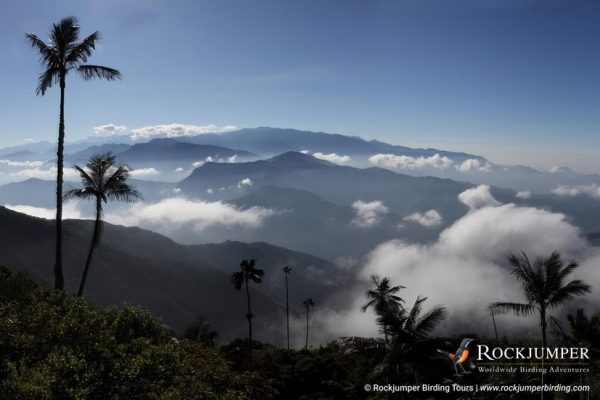
What transpired over the subsequent 27 days would become something of a legend in my mind, events that I can only recall bits and pieces of now, nearly 4 years hence. It was intense, and overwhelming, in the way only a journey seldom undertaken by any sane individual can be. It was a journey that spanned from the eastern border shared with Brazil to the west, across all three Andean ranges within Colombia, the two vast river valleys in between, as well as a trek through the coastal and montane habitats of the Santa Marta range and Guajira Peninsula to the north. We had days in sweltering rainforests following ant swarms and standing in awe of Guianan Cock-of-the-Rocks on lek. We had days in freezing paramo, standing in awe of a Buffy Helmetcrest feeding on the most beautiful bright purple flowers imaginable, just after enjoying Rufous-fronted Parakeets flying out of the rock crevice they roost in. We had days everywhere in between, right down to an afternoon stroll on the beach with Flamingoes.
Summing up the experience of that first Colombia Mega trip, for me, would take far more words than anyone would care to read, or I’d care to write, because all I would accomplish would be an utter failure to convey the sense of wonder, respect for nature and culture, and camaraderie we felt as we became more of a unit with each new bird, new forest and new town we visited. It was really something…special…for a lack of a better word. I would have to spend as much time discussing all the wonderful personalities involved in that trip as I would have to spend on the logic and planning that went into it. But rather than do any of the above, I’ll just write about what our group remembered as the Top 10 sightings of that month we spent together, doing my best from recollection and the trip report I wrote shortly after returning home. I greatly appreciated the time that folks put into their voted Top 10 lists. Choosing but 10 out of the 1,025 species we recorded on the tour was a ridiculous request and more frustrating and heart-rending than I can imagine. Parting with 1,025 species, to come up with but TEN A-listers is borderline disrespectful to the unmentioned. But it was done enthusiastically, and with great care.
10. Bare-crowned Antbird Gimnocichla nudiceps
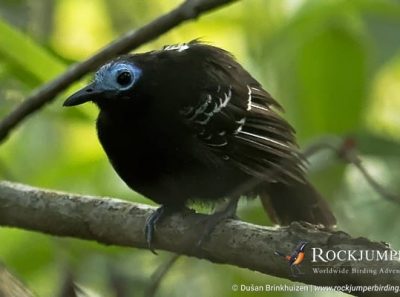
Antbirds are famous among neotropical bird enthusiasts as being iconically, well, neotropical. Their cryptic plumages and elusive natures only amplify the elation of a truly intimate encounter with one of the members of the family. They blend in with the undergrowth and tangles they inhabit. They are heard far more often than seen and reach their epicentre of diversity in the most neotropical of places: the Amazon Basin. Arguably, Bare-crowned Antbird is the most bizarre of the lot. Further arguments might suggest it’s one of the most bizarre-looking birds anywhere.
It’s a hefty, stout and loud bird of thick tangles in thick jungles, where the only thing thicker than the layer of deet one needs apply in the attempt to access its habitat is the humidity of the air one needs wade through. It requires patience and a heavy dose of motivation-to-see, in order to catch a tickable view of the species. It requires something along the order of divine intervention to experience what we experienced with this bird: a male, in the company of a female, that came up out of a ravine to sit on a bare branch no more than 3 metres from us and sing. In full view! As part of a courtship and territorial routine, the male of the species may flare hidden white mantle feathers to impress. He did this, then sang some more. So, how does a member of a relatively dull (though in my opinion incredibly ornate and complexly-plumaged) family made it into the Top Ten? – By becoming truly intimate with our company in a manner far exceeding any expectation.
9. Crested Ant Tanager Habia cristata
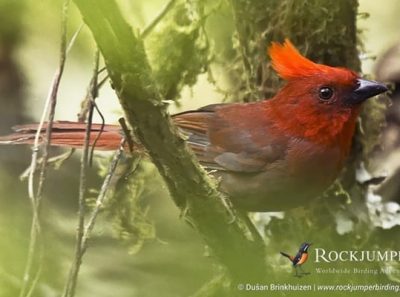
This species requires far less explanation. Firstly, the species inhabits a tiny range that spans a short distance on the Western Cordillera and an even smaller span on the Central Range. It is a hoped-for endemic species. The fact that the bird is bright red, with a towering, radiant, neon-pink crest that glows amidst the brown and green mossy montane forests it inhabits doesn’t hurt its appeal. It goes in flocks, usually family groups of 4 or more, making incessant squeaks, chirrups, creaks and buzzes as it wends through middle – and lower – storey growth. We had not one, but two magnificent run-ins with groups of this dynamic species; in both instances, enjoying fabulous, lengthy views.
8. Black Solitaire Entomodestes coracinus
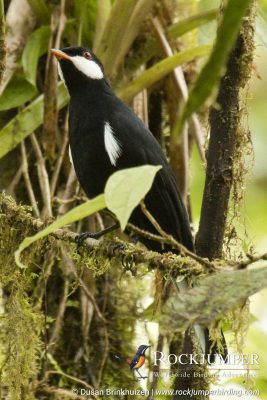
Some species of Solitaires are relatively common, widespread, or at the very least, numerous in appropriate habitats. Most are well-known in terms of their range, habitat preferences, food preferences and general biology. Very few are not. While I have seen more than a dozen Black Solitaires in one day (a most extraordinary day!), most encounters with Black Solitaire are of but one individual. Often enough, those encounters are unsatisfyingly brief given the species’ shy nature. This denizen of the wettest montane forests in the Western Andes is among the most anticipated species for any birder visiting the region, for it is as emblematic of the lush Choco bioregion as it is surprisingly graceful and lovely to behold. Seeing one is far from a guarantee, so we were all delighted when we found one perched low, right next to our deep forest trail, after it flushed off a nest! Amazing views were had of this dapper bird, right down to the incongruous staring red eye it sports.
7. Black-and-White Owl Ciccaba nigrolineata
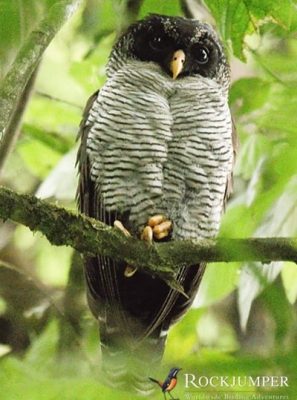
Many species on tour Top 10 lists are rare or range-restricted. The list often tends towards species that are unique to that particular country, or at least general region, and cannot be found elsewhere. This particular species of Owl is the opposite of that, being very widespread. It occurs throughout the Neotropics, from Central America south to Peru. It’s not particularly uncommon where it occurs and is certainly quite gregarious when found. It is also an impressively handsome bird that, despite the above, is always a treat to see. Owls on day roosts are especially nice. We enjoyed great looks at a roosting pair right above the roadway, as they got probably even better looks, down, at us. It was another intimate and very satisfying encounter with a beautiful bird.
6. White-capped Tanager Sericossypha albocristata
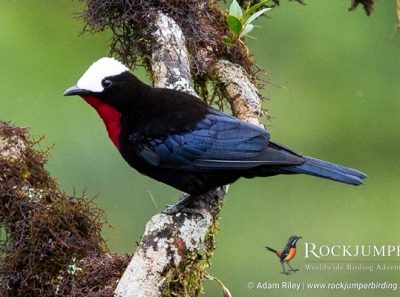
For decades, the word Tanager and the family Thraupidae were used as a catch-all for any bird smallish, colourful and prone to accompanying mixed flocks. Their shapes, colours and sizes boggle conventional comprehension of closely-related species. White-capped Tanager is one of the prime examples of a Tanager that defies the idea of a Tanager. It’s a large bird. Both longer and heavier than nearly all other tanagers. It’s loud. While most tanagers have very high-pitched songs and calls that don’t carry great distances, the vocalisations of White-capped Tanagers are easily detected from hundreds of metres away. White-capped Tanagers don’t join mixed-species flocks. While they might frequent areas that mixed flocks pass through due to mutual resource interests, White-capped Tanagers travel together in family groups, mostly independent of the mixed flocks that South America is famous for. It’s an outstanding bird that happens to have outstanding iridescent plumage, a gleaming snow-white head and a deep scarlet-red throat and chest. White-capped Tanagers are amazing birds! After hearing a distant group calling, I used playback during our last day in their possible habitat (upper subtropical/lower temperate forest from 2,400 to 2,900 masl) in the thin hope of luring them in for a view. True to their very curious nature, the flock of White-capped Tanagers flew across the valley and descended upon us in a hail of raucous squawks and outlandish colour, until a few individuals were no more than 5 metres away! Though but one member of a family we had recorded more than 100 species of during our time in Colombia, we stood agape, glowing, as these scarce, stunning birds paraded about us, giving us one of the most memorable experiences a birder could ever hope for.
5. White-tipped Quetzal Pharomacrus fulgidus
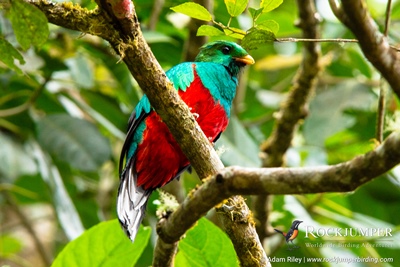
As we were descending from the highest access in the Santa Marta range, I heard the distinctive “giggle” of a Quetzal. While the advertising song of males carries far and typically consists of a series of disyllabic tones repeated at interval, Quetzals utter a litany of less-obvious cackles, giggles, pips and so forth. It took less than two minutes after stepping out of the vehicles, and but a strophe or two of “giggles” I had recorded on a previous visit, before we were face-to-face with a stunning adult male White-tipped Quetzal. This species is restricted to the few coastal mountain ranges of north-eastern Colombia and north-western Venezuela. A combination of the allure of a range-restricted, rare species, and the undeniable beauty and charisma of this huge green-and-red bird secured this species’ position in the Top 5.
4. Azure-naped Jay Cyanocorax heilprini
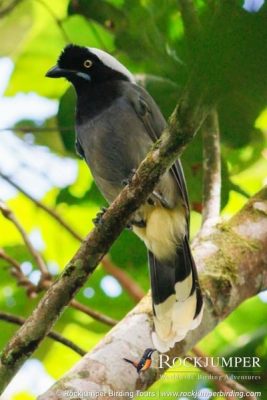
This species is known from but a handful of locations. Being restricted to depleted sandy soil forests in the north-western reaches of the Amazon basin, reasonable access and opportunity to see this beautiful bird is limited to merely two options. Mitu is one of those options. Where one is most likely to encounter a group of this highly sought-after bird just happens to involve a short hike up the side of an incredible dome of rock, not at all dissimilar from a small tepui. Reaching well over 100 metres above the surrounding rain forest, the viewpoint is marvellously humbling, with nothing but vast green wilderness stretching out beyond eye’s reach, impeded only by a few neighbouring tepuis jutting up out of the perfect green, like a series of forgotten mistakes. In this case, atmosphere and environment probably had as much to do with this species’ inclusion in the Top Ten as, perhaps, the nature and beauty of the bird itself. The bird is a beautiful one, with subtle gradients of shock blue into dusky grey, even white, and a gleaming yellow eye that gives it an air of comprehension and curiosity which the bird’s behaviour seems to affirm. Our experience with a flock of 5 individuals cavorting atop an emergent tree just above eye-level on the slope below us was certainly a memorable one, with Umbrellabirds displaying and Parrots coming in to roost in the background as we gazed across the treetops to a sunset horizon.
3. Chestnut-crested Antbird Rhegmatorhina cristata
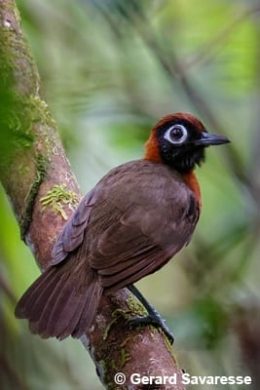
Chestnut-crested Antbird belongs to my favourite genus of birds on the planet, and a very unique one: Rhegmatorhina.Rhegmatorhina antbirds are among those that give this group of birds their particular name – they are truly ant-following birds. They are among the “antswarm obligates”. “Obligate” antbirds have a very special dispensation for following and capitalising off of antswarms. More so than other Antbirds, which can survive handily without a proliferation of army ants to scare up their food, obligates feed chiefly on the plethora of creatures that reveal themselves in their effort to evade a grisly death in the jaws of multiple army ants. All antbirds seem to fend for themselves in scoring plenty of invertebrate fodder. These obligate antbirds will, unlike others, follow antswarms for days. They defend their spot at the leading edge of the swarm, aggressively holding their advantageous position with a number of antics, eating the choicest of prey items rustled up by the relentless tide of voracious ants. Over time, these species have evolved to become seemingly dependent on these swarms and are known to abandon territories, temporarily, on a whim to follow ants. This also means that, by sheer probability, a birder is unlikely to see an obligate antbird without the benefit of finding the antswarm. Antswarms are ephemeral, temporary, dependent on weather and hard to follow unless you have wings and can easily manoeuvre between trees, shrubs, tangles of vines, etc. Add to that the low density of obligate antbirds, even in the most pristine of forest ecosystems, and a visiting birder could easily say that dumb luck (the convergence of too many factors to calculate) plays a huge part in getting to see one of these types of birds. Rhegmatorhina antbirds also happen to be the most handsome and charismatic of the lot, responding to playback with crests fully distended, brightly-coloured orbital skin accentuating their large eyes, as they encircle the intruding entity; while calling incessantly in their curiosity. Therefore, it’s no surprise that this species, which did exactly what I described above, won a top spot amongst the highlights of our time in Colombia. We had a family group of four put on an amazing show for us, taking time away from their antswarm to show us how exciting antbirds can be!
2. Guianan Cock-of-the-Rock Rupicola rupicola
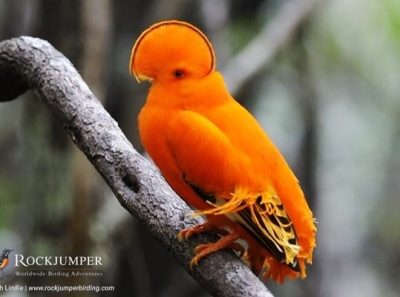
One of the most iconic birds of the continent, and one of the most striking birds on Earth, is unquestionably the Guianan Cock-of-the-Rock. Bright orange, with wings bannered in black and white and the signature, bizarre, tuft of feathers on the forehead covering the bill, witnessing Cock-of-the-Rocks on lek is one of those essential must-dos for any world birder to experience. Mitu has the most impressive lek I’ve ever seen of this species. With, at times, 7 lekking males displaying some 6 metres off the trail, the views to be had here of this astonishing species and its unique breeding behaviour are unrivalled. The trek to get to the lek site is equally memorable, requiring a pre-dawn departure out the only road leaving town, then a transfer to a tractor-drawn flatbed trailer, before reaching the community where one disembarks to begin walking through the forest for a few kilometres to the lekking arena, birding the entire way. The previous species in our Top Ten list was seen the very same day, only minutes after departing the lek. No fewer than 146 species were recorded that day in the forest. Again, it’s not only the bird itself but the journey and everything about the place that makes these birds so special. Of course, being painfully bright orange and owning a vocabulary reminiscent of sound effects on a Sci-Fi movie goes a long way to endear one’s self to visiting birders.
1. Santa Marta Screech Owl Megascops sp. nov.
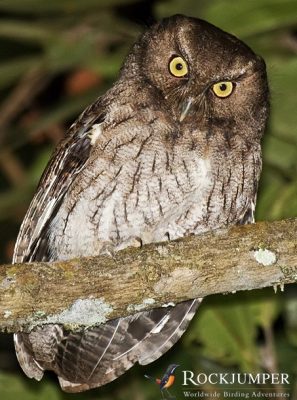
There is something undeniably satisfying about seeing an “undescribed” species. There is a great feeling of wonder, accompanied by the quenching of a deep-seated curiosity that can be experienced upon encountering a bird that is so “new”. Such is the case with the Santa Marta Screech Owl. It was suspected for years to be a new species based on recordings made decades earlier, though finding the birds for study proved difficult enough to thwart efforts into its discovery until the late 2000’s, when a lodge was built, as luck would have it, right in the middle of a breeding pair’s territory. The rest is, as they say, history. Though given the as-of-yet-undescribed status, it is certainly current history. While the pair breeding near the lodge grounds became fairly well-known and somewhat regularly encountered, the true range of this species is unknown, as are many of its habits. Access to this species’ range only occurs via one road that travels up onto the San Lorenzo Ridge of the Santa Marta range. The one road is only suitable for four-wheel-drive vehicles with exceptionally high clearance, heavy suspension, a skilled driver that knows the road well, and a month’s supply of Dramamine. Observed individuals of this species number somewhere between 10 and 20 individuals, seen at an elevation range of between about 1,800 to 2,600 metres. The total of what we know about the species can be summed up in a few paragraphs, and it is unclear whether the total global population is 100 or 1,000 or more, or less. We just don’t know much about this very special, extremely vulnerable, species. Therefore, when we were able to enjoy leisurely views of this lovely, quite colourful, screech owl on a day roost at the very well-appointed lodge aforementioned, it quickly shot to the top of our list of tour Highlights, despite some fascinating and jaw-dropping competition. We had checked known roost sites the two days prior, as well as attempting at night, in vain, to lure one in. Though we had nearly given up on the species, one last check of the most visible and most easily accessed roost site proved successful!!! This was very near the end of our tour, and though not the final highlight (we had some 30+ species to go to reach 1000), the experience of finally finding the owl felt somehow symbolic of the entirety of our efforts in the field during this wonderful month of birding.
I have guided two Mega Tours since our first attempt in 2013, of which I reminisce in this article. All have had varying degrees of success, with my recent attempt barely reaching the mark. To date, I believe our 2014 tour, which tallied a remarkable 1,044 species, remains the highest tour total of any group, ever. With such a tempting goal looming, new records will surely be set. I hope that those undertaking the endeavour enjoy the amazing journey as much as I have, wherever it may lead them. I freely admit that Colombia is among my top 3 countries of the 49 I’ve known, in terms of birds and birding. The culture, the scenic beauty, and the warmth I’ve felt over the years from this amazing country’s native inhabitants is perhaps what makes it, arguably, my favourite country of all.
Que Viva Colombia!
Good Birding, to you all.
